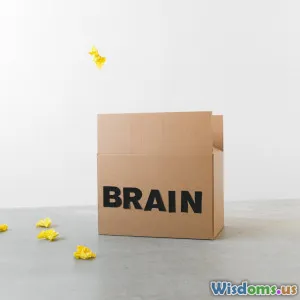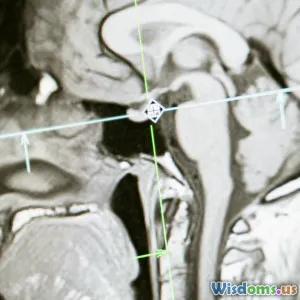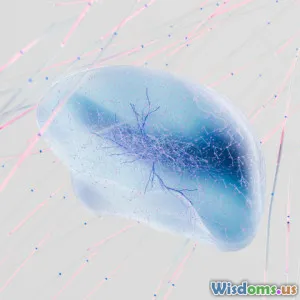
How Brain Activity Influences Our Dream Experiences
10 min read Explore how brain activity shapes our dreams and uncovers the mysteries behind their vivid, emotional, and narrative nature. (0 Reviews)
How Brain Activity Influences Our Dream Experiences
Dreams have fascinated humans for millennia, seen as gateways to another world, prophetic visions, or psychological mirrors. But what underlies these surreal nightly voyages? Advances in neuroscience reveal that brain activity is not just involved but fundamentally shapes the landscapes and emotions of our dreams. This article explores the dynamic neural processes behind dreaming, revealing how specific brain structures and their activity patterns sculpt the experience of our dreams.
The Enigma of Dreaming: A Neural Perspective
Historically, dreams were interpreted through cultural, spiritual, or psychoanalytic lenses. However, modern brain science treats dreams as neural phenomena emerging from complex activity during sleep — especially the Rapid Eye Movement (REM) phase. REM sleep is characterized by rapid eye movements, muscle atonia, and specific electrophysiological features such as low-amplitude mixed-frequency EEG activity.
The question neuroscientists ask is: How does this unique brain activity generate the rich, often bizarre, yet emotionally intense experiences we call dreams?
Key Brain Regions Involved in Dream Generation
1. The Limbic System: The Emotional Core of Dreams
Dreams are often emotionally charged, varying from bliss to terror. The limbic system — particularly the amygdala and hippocampus — plays a central role here. The amygdala, a core center for processing emotions such as fear and pleasure, exhibits heightened activity during REM sleep, which helps explain why many dreams evoke strong emotions.
Research using functional magnetic resonance imaging (fMRI) shows increased amygdala activation during REM periods compared to wakefulness. For example, a study by Maquet et al. (1996) demonstrated that the amygdala's hyperactivity correlates with the emotional intensity of dreams. Meanwhile, the hippocampus supports the integration of memories into dream narratives, enabling the recombination and replay of experiences.
2. The Prefrontal Cortex: Diminished Reasoning and Logic
Interestingly, the dorsolateral prefrontal cortex (DLPFC), responsible for critical thinking and self-awareness, shows decreased activity during REM sleep. This deactivation results in the loss of executive control, explaining why dreams often lack logical coherence or continuity. For instance, bizarre scene shifts and acceptance of improbable scenarios occur because the brain’s reasoning centers are ‘offline.’
3. Visual Cortex and Association Areas: The Vivid Imagery Generator
Dreams are mostly visual experiences. The primary visual cortex (V1) and associative visual areas show activation patterns during REM sleep, supporting the generation of vivid imagery. This mimics the brain’s activity during wakeful visual perception but without external input, illustrating that dreams are essentially internally-generated visual hallucinations.
Interestingly, the occipital lobe's activation during REM contrasts with non-REM sleep stages, which show much less visual cortex engagement, further supporting REM’s role in producing dream imagery.
4. The Thalamus: The Gateway to Dream Content
The thalamus acts as a relay center for sensory and motor signals and is involved in synchronizing cortical rhythms. During REM sleep, there is a unique thalamocortical dynamic that appears to facilitate the generation of dream imagery and narrative flow by gating sensory input and promoting intracortical communication.
Neural Mechanisms and Dream Phenomena
Brain Waves and Dream States
Brain activity patterns differ vastly between sleep stages.
- REM sleep is marked by theta (4–8 Hz) and beta (12–30 Hz) waves mixed with rapid eye movements and muscle atonia.
- Non-REM sleep features slower delta waves.
Studies link theta oscillations to memory processing and the generation of emotional dream content. For example, a study published in Nature Neuroscience (2019) found that higher frontal theta power predicted subsequent dream recall and emotional intensity. This supports the idea that the brain dynamically tunes its rhythms to support dreaming.
Neurotransmitter Influence
Chemical brain states during sleep differ sharply from wakefulness and shape dreams dramatically:
- Acetylcholine levels increase during REM sleep, enhancing cortical activation supporting vivid dreams.
- Serotonin and norepinephrine levels drop, which may reduce critical evaluative processes, hence the bizarre yet accepted dream logic.
Pharmacological studies show that manipulating these neuromodulators alters dreaming patterns. For example, antidepressants that affect serotonin levels often suppress REM sleep and dream vividness.
How Brain Activity Explains Varied Dream Experiences
Lucid Dreaming: Regaining Prefrontal Control
Lucid dreaming—when the dreamer is aware they are dreaming—has been linked to a reactivation of the DLPFC during REM sleep. Using EEG and fMRI, researchers found that lucid dreamers exhibit higher activity in the prefrontal cortex compared to typical REM sleep.
This partial regain of executive function implies that brain activity modulation can influence dream awareness and control, pointing to a fascinating nexus of brain activity and conscious experience.
Nightmares and Anxiety Dreams
Heightened amygdala and limbic system activity coupled with low prefrontal inhibition might explain nightmares. For example, PTSD patients often report increased nightmare frequency, paralleling hyperactive amygdala responses seen in fMRI studies.
Emerging treatments such as targeted brain stimulation or psychotherapy aim to modulate this limbic-prefrontal balance to reduce nightmare intensity.
Dream Recall: The Role of Brain Connectivity
Why do some people remember dreams vividly while others rarely recall them? Functional connectivity between the hippocampus and prefrontal cortex during sleep may influence this.
Researchers at the University of Toronto demonstrated that individuals with stronger connectivity between memory and executive regions before and after sleep recall more dreams. This suggests dream recall is tied not only to dreaming itself but to how the brain consolidates and retrieves these experiences.
Practical Implications and Future Directions
Understanding brain activity during dreaming holds potential beyond curiosity:
- Sleep Medicine: Insight into neural dream generation helps develop treatments for sleep disorders like REM behavior disorder and nightmares.
- Mental Health: Since dreams process emotions and memories, this knowledge aids therapies for PTSD, anxiety, and depression.
- Neuroscience of Consciousness: Dreaming studies inform wider questions about consciousness, creativity, and memory.
Future research may employ advanced brain imaging and stimulation techniques to decode, manipulate, or enhance dream experience, opening unprecedented avenues for therapy and cognitive enhancement.
Conclusion
Dreams arise from the complex interplay of brain regions and neural rhythms during sleep. Heightened limbic activity ignites emotional scenes, subdued prefrontal functions relax reality checks, and active visual cortices paint vivid internal worlds. This neural ballet forms the tapestry of our dream experiences—emotionally intense, visually rich, and sometimes strikingly meaningful.
By unraveling how brain activity shapes dreams, we not only decode a universal human mystery but gain profound insights into how the mind weaves consciousness, memory, and emotion. The night, illuminated by neural activity, continues to offer a remarkable frontier where science and experience converge.
References
- Maquet, P., et al. (1996). Functional neuroanatomy of human rapid-eye-movement sleep and dreaming. Nature, 383(6596), 163-166.
- Voss, U., et al. (2009). Lucid dream induction by transcranial Direct Current Stimulation of the frontal lobe. Brain, 132(Pt 9), 2468-2476.
- Siclari, F., et al. (2019). The neural correlates of dreaming. Nature Neuroscience, 22(6), 767–774.
- Nielsen, T. (2010). Remembering and Forgetting Dreams: The Role of the Prefrontal Cortex and Sleep Stages. Frontiers in Psychology.
Author's Note: Understanding the neuroscience behind dreams not only enriches our scientific knowledge but may empower us to harness dreams for psychological healing and creative inspiration.
Rate the Post
User Reviews
Popular Posts




















